Food Encapsulation Market Size
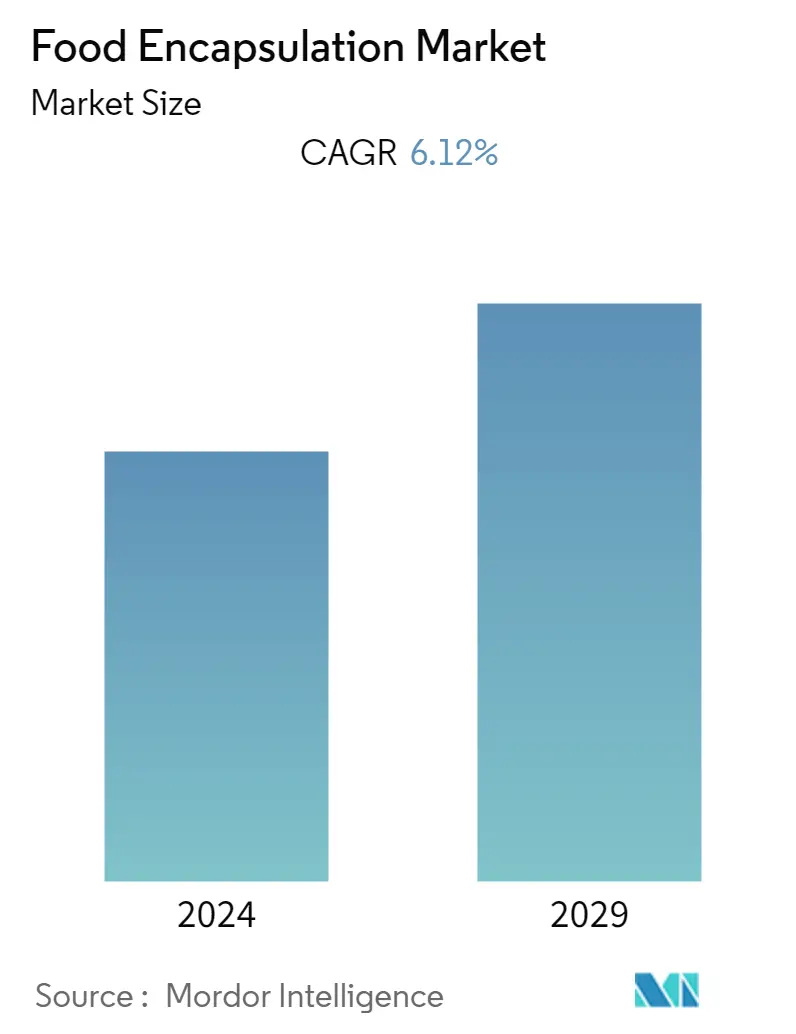
| Study Period | 2019 - 2029 |
| Base Year For Estimation | 2023 |
| CAGR | 6.12 % |
| Fastest Growing Market | Asia Pacific |
| Largest Market | North America |
| Market Concentration | Low |
Major Players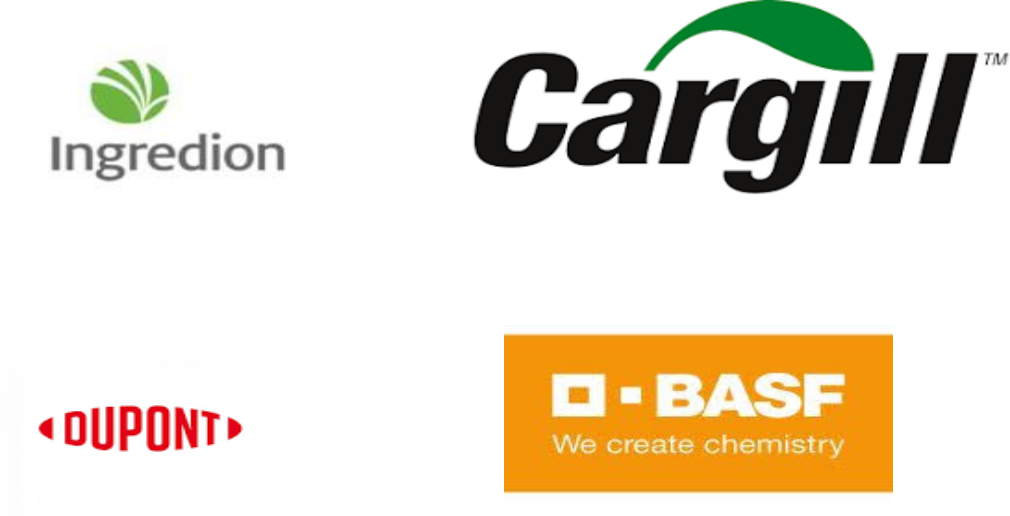
*Disclaimer: Major Players sorted in no particular order |
Food Encapsulation Market Analysis
The global food encapsulation market is projected to grow at a CAGR of 6.12% during the forecast period (2020 - 2025).
- Encapsulation is an important tool for improving the delivery of living cells and bioactive molecules into foods. Food-grade, biodegradable materials must be used for designing the protective shell of encapsulates and they must be efficient in forming a barrier between the internal phase and its surroundings.
- Microencapsulation of essential oil, like Omega 3 with sugar beet pectin is an alternative innovative encapsulating agent than the traditional one. Maintenance of the stability of encapsulated food, especially during packaging and processing, is a major hindrance for food encapsulation industries.
Food Encapsulation Market Trends
This section covers the major market trends shaping the Food Encapsulation Market according to our research experts:
Growing Demand of Dietary Supplement
The dietary supplements market is preliminarily driven by the paradigm shift toward preventive health management practices, amid rising healthcare costs and increasing burden of lifestyle diseases. Dietary supplements such as vitamins, minerals, Omega 3, enzymes, etc. are growing owing to increasing health awareness among consumers. Ingredients, which are difficult to gain through food, can be fulfilled through a supplement to meet the dietary requirements, where encapsulation plays a major role in order to maintain taste, color, preservation, and nutrition of the product. The Asia-Pacific is the fastest-growing market for supplements.
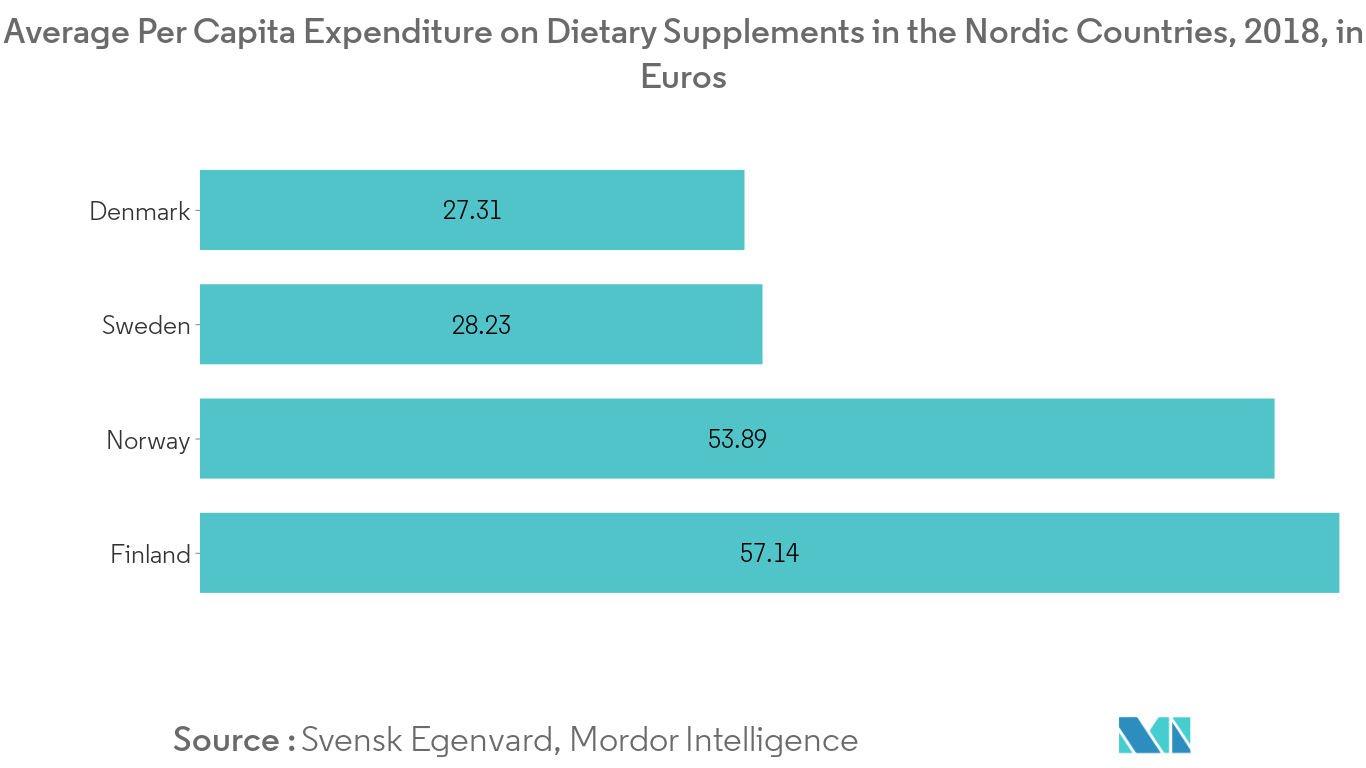
North America Dominate the Market
North America holds the largest share in the food encapsulation market globally. The high availability of shell materials such as hydrocolloid, emulsions and the presence of a large number of manufacturers are contributing to the growth of the region. The Asia Pacific is has witnessed significant growth in the last couple of years, owing to the increasing demand for processed food and the flourishing food and beverage industry. The growth of the region is also fuelled by rapid urbanization, rising disposable income, improving living standards, particularly in emerging countries including China and India. The growth of Europe can be attributed to the increasing advancements in technologies used in the processed food sector.
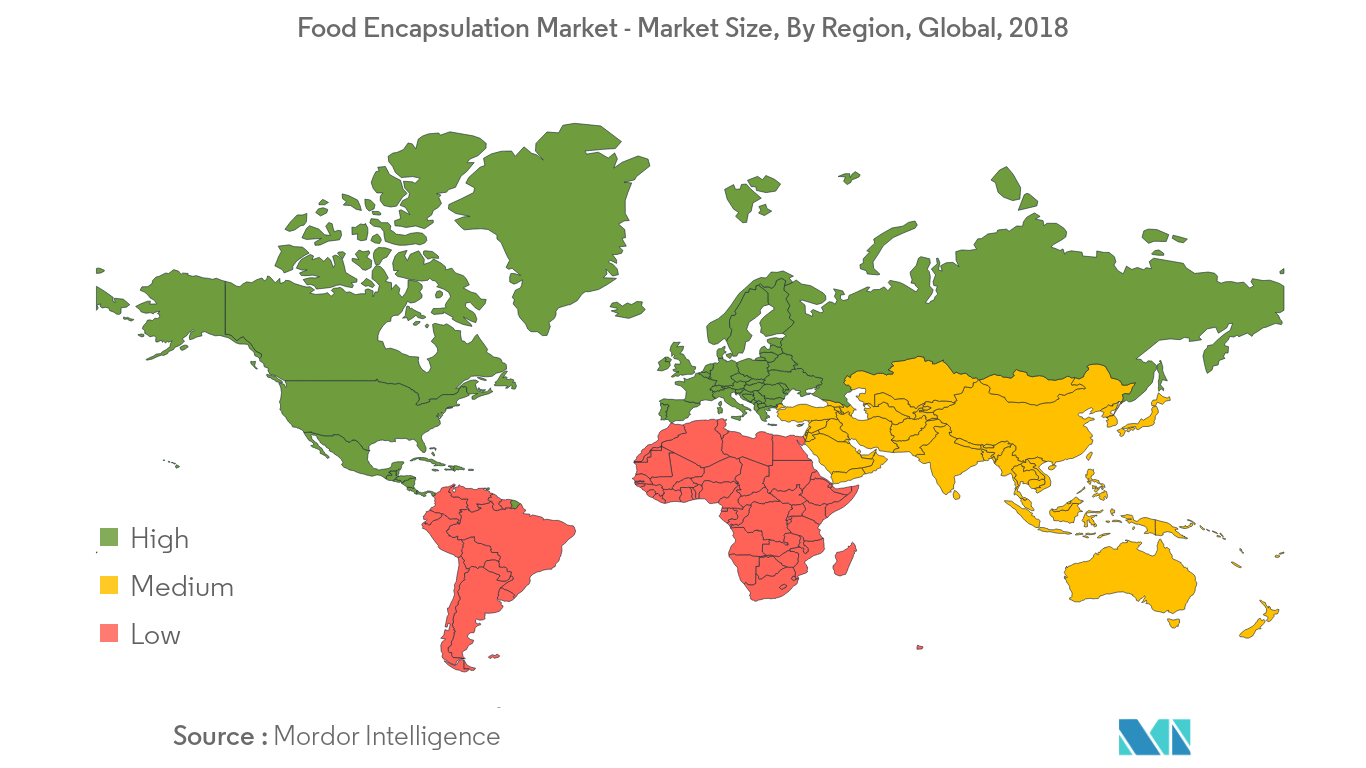
Food Encapsulation Industry Overview
Some of the major key players in the food encapsulation market, globally includes BASF SE, ADVANCED BIONUTRITION CORP, Cargill, Incorporated, DuPont, Frieslandcampina Kievit, among others.
Food Encapsulation Market Leaders
-
BASF SE
-
ADVANCED BIONUTRITION CORP
-
Cargill, Incorporated
-
DuPont
-
Frieslandcampina Kievit
*Disclaimer: Major Players sorted in no particular order
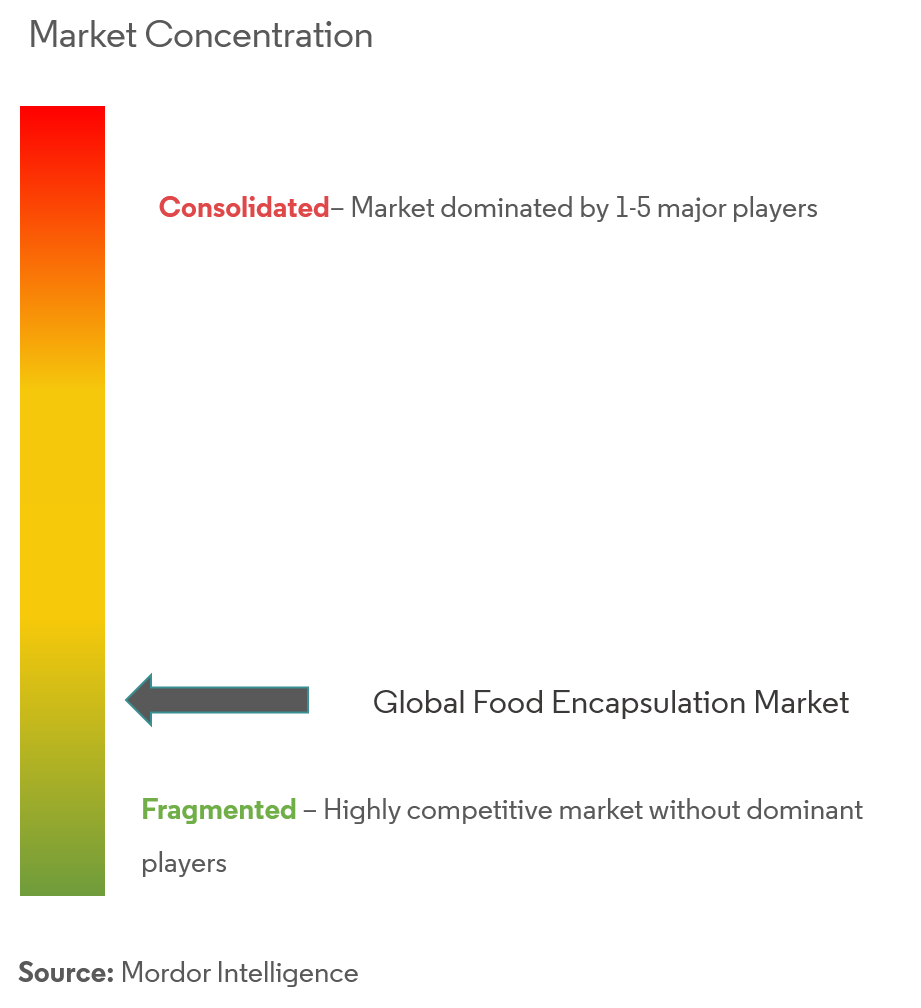
Food Encapsulation Market Report - Table of Contents
1. INTRODUCTION
- 1.1 Study Deliverables
- 1.2 Study Assumptions
- 1.3 Scope of the Study
2. RESEARCH METHODOLOGY
3. EXECUTIVE SUMMARY
4. MARKET DYNAMICS
- 4.1 Market Drivers
- 4.2 Market Restraints
-
4.3 Porter's Five Force Analysis
- 4.3.1 Threat of New Entrants
- 4.3.2 Bargaining Power of Buyers/Consumers
- 4.3.3 Bargaining Power of Suppliers
- 4.3.4 Threat of Substitute Products
- 4.3.5 Intensity of Competitive Rivalry
5. MARKET SEGMENTATION
-
5.1 By Technology
- 5.1.1 Microencapsulation
- 5.1.2 Nano encapsulation
- 5.1.3 Hybrid technologies
-
5.2 By Material Type
- 5.2.1 Polysaccharides
- 5.2.2 Proteins
- 5.2.3 Lipids
- 5.2.4 Emulsifiers
- 5.2.5 Other Shell Materials
-
5.3 By Core Phase
- 5.3.1 Vitamins
- 5.3.2 Minerals
- 5.3.3 Enzymes
- 5.3.4 Organic Acids
- 5.3.5 Additives
- 5.3.6 Probiotics
- 5.3.7 Prebiotics
- 5.3.8 Essential oils
- 5.3.9 Other Core Phase Materials
-
5.4 Geography
- 5.4.1 North America
- 5.4.1.1 United States
- 5.4.1.2 Canada
- 5.4.1.3 Mexico
- 5.4.1.4 Rest of North America
- 5.4.2 Europe
- 5.4.2.1 United Kingdom
- 5.4.2.2 Germany
- 5.4.2.3 France
- 5.4.2.4 Russia
- 5.4.2.5 Italy
- 5.4.2.6 Spain
- 5.4.2.7 Rest of Europe
- 5.4.3 Asia Pacific
- 5.4.3.1 India
- 5.4.3.2 China
- 5.4.3.3 Japan
- 5.4.3.4 Australia
- 5.4.3.5 Rest of Asia-Pacific
- 5.4.4 South America
- 5.4.4.1 Brazil
- 5.4.4.2 Argentina
- 5.4.4.3 Rest of South America
- 5.4.5 Middle East & Africa
- 5.4.5.1 South Africa
- 5.4.5.2 Saudi Arabia
- 5.4.5.3 Rest of Middle East & Africa
6. COMPETITIVE LANDSCAPE
- 6.1 Most Active Companies
- 6.2 Most Adopted Strategies
- 6.3 Market Share Analysis
-
6.4 Company Profiles
- 6.4.1 BASF SE
- 6.4.2 ADVANCED BIONUTRITION CORP
- 6.4.3 Cargill, Incorporated
- 6.4.4 DuPont
- 6.4.5 Ingredion Incorporated
- 6.4.6 GAT Food Essentials GmbH
- 6.4.7 Encapsys, LLC.
- 6.4.8 Frieslandcampina Kievit
- *List Not Exhaustive
7. MARKET OPPORTUNITIES AND FUTURE TRENDS
** Subject To AvailablityFood Encapsulation Industry Segmentation
The global food encapsulation market is segmented by technology, material type, core phase. Based on technology, the market is segmented into microencapsulation, nanoencapsulation, hybrid technologies. On the basis of material type, the market is segmented into polysaccharides, proteins, lipids, emulsifiers, other shell materials. On the basis of the core phase, the market is segmented into vitamins, minerals, enzymes, organic acids, additives, probiotics, prebiotics, essential oils, other core phase materials. On the basis of geography, the study provides an analysis of the food encapsulation market in the emerging and established markets across the globe, including North America, Europe, Asia-Pacific, South America, and Middle East & Africa.
| By Technology | Microencapsulation | |
| Nano encapsulation | ||
| Hybrid technologies | ||
| By Material Type | Polysaccharides | |
| Proteins | ||
| Lipids | ||
| Emulsifiers | ||
| Other Shell Materials | ||
| By Core Phase | Vitamins | |
| Minerals | ||
| Enzymes | ||
| Organic Acids | ||
| Additives | ||
| Probiotics | ||
| Prebiotics | ||
| Essential oils | ||
| Other Core Phase Materials | ||
| Geography | North America | United States |
| Canada | ||
| Mexico | ||
| Rest of North America | ||
| Geography | Europe | United Kingdom |
| Germany | ||
| France | ||
| Russia | ||
| Italy | ||
| Spain | ||
| Rest of Europe | ||
| Geography | Asia Pacific | India |
| China | ||
| Japan | ||
| Australia | ||
| Rest of Asia-Pacific | ||
| Geography | South America | Brazil |
| Argentina | ||
| Rest of South America | ||
| Geography | Middle East & Africa | South Africa |
| Saudi Arabia | ||
| Rest of Middle East & Africa |
Food Encapsulation Market Research FAQs
What is the current Food Encapsulation Market size?
The Food Encapsulation Market is projected to register a CAGR of 6.12% during the forecast period (2024-2029)
Who are the key players in Food Encapsulation Market?
BASF SE, ADVANCED BIONUTRITION CORP, Cargill, Incorporated, DuPont and Frieslandcampina Kievit are the major companies operating in the Food Encapsulation Market.
Which is the fastest growing region in Food Encapsulation Market?
Asia Pacific is estimated to grow at the highest CAGR over the forecast period (2024-2029).
Which region has the biggest share in Food Encapsulation Market?
In 2024, the North America accounts for the largest market share in Food Encapsulation Market.
What years does this Food Encapsulation Market cover?
The report covers the Food Encapsulation Market historical market size for years: 2019, 2020, 2021, 2022 and 2023. The report also forecasts the Food Encapsulation Market size for years: 2024, 2025, 2026, 2027, 2028 and 2029.
What are the major challenges faced in the Food Encapsulation Market?
The major challenges faced in the Food Encapsulation Market are a) High cost of encapsulation technologies and materials b) Navigating complex regulations for food additives and encapsulation materials can be time-consuming and require adherence to strict safety protocols
Food Encapsulation Industry Report
The food encapsulation market is thriving due to rising demand for advanced food processing technologies and a growing preference for functional and fortified foods. Key techniques like microencapsulation and nanoencapsulation enhance the stability, bioavailability, and controlled release of sensitive components such as vitamins, minerals, enzymes, and flavors, ensuring the preservation of nutritional quality and sensory characteristics during storage and consumption. Polysaccharides lead in material type segments, known for their functional properties. This technology finds extensive applications across food categories like functional foods, dietary supplements, and bakery products, meeting consumer demands for healthier options. Continuous innovations in encapsulation are solving compatibility challenges between ingredients and boosting product stability across varying environments. The sector is poised for ongoing expansion, propelled by technological progress and heightened consumer health consciousness. For an in-depth market forecast outlook and analysis, obtain a free report PDF sample from Mordor Intelligence™ Industry Reports.



